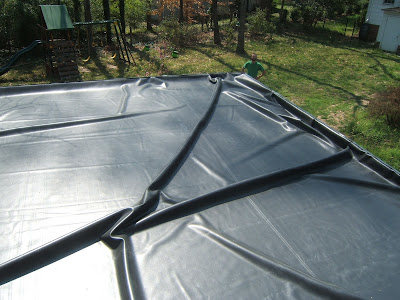Green roofs are somewhat deceptive. The plants may be green, but under all that lush growth often lies a dead black petroleum based waterproof membrane. Some green roofs even have multiple layers of perforated polyethylene drainage mats, rigid foam sheets, root-barrier membrane...We didn't go so far, but we did get ourselves a nice fat EPDM sheet.
EPDM pond liners are commonly used as the water proof membrane in green roofs. They're pretty tough, but should be isolated from the roof deck and soil layer, to make sure they don't get punctured. We separated ours with layers of rigid foam insulation. The pond liner wraps up and over the 2x10 fascia to create an enclosed pan for the soil, which drains in the low spots via PVC shower pan drains.
The soil on the roof is the topsoil that used to live where the building is. In creating the pad and footing, we made sure to separate topsoil for the roof, and subsoil for cob. Check back this summer to see how things are growing up there.


Having a durable pond liner is essential in building green roofs. Not only does it serve as a shielding for your roofs, it also protects your plants from pests, dust and extreme temperatures. Using a sturdy pond liner is a big component that contributes to the success of a green house. Despite of its sturdiness, however, it is still important to protect them from sharp objects in order to prevent it from puncture holes which could lead to leakage.
ReplyDeleteJeleryl Comisky
The plastic protects the main frame of the roof from humidity and soil dirt. But since it’s plastic, you need to make sure that you take good care of it to prevent punctures and leakages as you complete the building process. Indeed, building a green roof is a challenging task, but completing such a project is definitely rewarding.
ReplyDeleteBrendan Gertner